ENTS,
It has been a few weeks since the forest summit, and I have been
meaning
to write a brief report from my perspective on the event. I also
am
behind on the website, stuff to do around the house,…..
I arrived at Bob’s house Thursday evening. As I walked in the
living
room I was greeted by many ENTS who had already arrived: Jess
Riddle,
Dale Luthringer, Will Blozan, Bob Leverett, Carl Harting,
Anthony
Kelley, Holly Post, Lee Frelich, and one person I didn’t know.
Will and
Dale bowed down and intoned “Hail to the all powerful
webmaster.” The
man I didn’t know was Dr. Michael Kudish. He was going to talk
on old
growth/primary forest in the Catskills and Adirondacks. I heard
an
account of their days activities at Robinson State Park, general
visiting and getting caught up with everyone. Lee whipped out
his flash
drive and said here is 400 years of fire history in the boundary
waters.
I pulled out my flash drive on my key chain, and Dale pulled out
his
flash drive hanging around his neck. Most of the people left
late that
evening to stay at Monica’s. Some of us stayed at Bob’s.
Bob’s son Rob
stopped down later and he talked of the geology and history of
the area.
Eventually we all were off to bed.
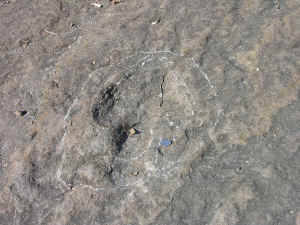
The next morning Holly, Michael, Anthony, and I went to Dinosaur
Footprints Reservation. This is a small roadside park just a
couple
miles up the road from Bob’s house. At the park, in the shadow
of the
roadway, is a series of dinosaur footprints in a sandy
siltstone. The
sign explains there are 134 footprints that make up 27 distinct
pathways
dating from 190 million years ago related to tectonics in the
Connecticut River Valley taking place at that time.
Bob met us back at the house around noon, or so and we headed of
to the
Forest Summit so that various presenters in our party could get
set-up.
Most of us gave Gary Beluzo our flash drives with presentations.
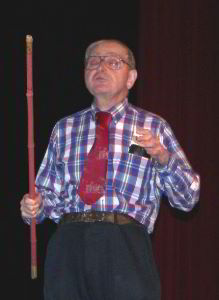 Dr. Michael Kudish Dr. Michael Kudish
Dr.
Kudish had a slide show with maps. After the introductions, Dr.
Kudish
gave his talk. He had slides from the Catskills and Adirondacks.
He
had charts taped to stands that kept trying to fall over as we
set up.
He had large maps taped to the walls. It was a different feel
for his
presentation. He was animated and had series of props he used.
At one
point he donned a train engineers hat and blew a wooden whistle
that
made train whistle sounds. Very animated and enjoyable.
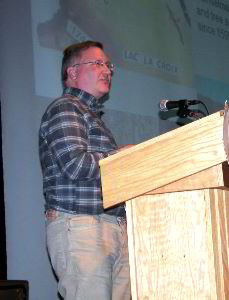 Dr. Lee Frelich
Dr. Lee Frelich
Next was Lee Frelich’s presentation on forest fire history in
the
boundary waters of Minnesota. Areas of fire overlaid each other
making
a complex mosaic over time. The final portion of the program
dealt with
the Cavity Lake Fire from last summer (2006). There is a cliché
that
guys like explosions in movies. I must admit I enjoyed the
photos of
massive flames and destruction. Lee’s student had study plots
in the
area to look at various forest processes. Then part way through
that
investigation there was a massive blowdown in the area, so the
study
became one of blowdown regeneration. Then there was the Cavity
Lake
Fire, and it became a study of the forest fire. I believe he
said there
were 750 plots with a lot of data from each of these intervening
studies
prior to the area being burned over by the fires. An excellent
data set
that likely has not been duplicated. He talked of graduate
student
fleeing the oncoming fire by canoe. The fire jumped across a
lake
skipping from island to island, some as far as a mile apart. He
posed
the question of what are they accomplishing with firemen out
there with
shovels and rakes making fire breaks when the fire could jump a
mile
across open water. The massive amounts work spent fighting the
fire had
no obvious affect on the overall fire progression.
The next talk was Tom Diggins. He spoke of ongoing research at
Zoar
Valley and disturbances from wind and flooding in the history of
the
valley. He had nice charts of multivariate analysis - I am not
sure how
they work, but they looked impressive and seemed to mean
something to
Tom and others.
 Dr. Tony Damato
Dr. Tony Damato
The final talk of the afternoon session was by Tony D’Amato on
the
structure and dynamics of old growth forests in western
Massachusetts.
Tony gave an excellent overview of the various old growth
patches he had
been studying. He had everything down well as he was preparing
for an
upcoming PhD defense on the research. Most of the old growth
forests in
western Mass are dominated by hemlock systems - 16 out of 18
study plots
I believe (not 100% sure). What will become of these areas after
the
hemlock woolly adelgid invasion?
After the session we helped Dr. Kudish gather his materials and
we all
went to dinner. We had pushed together perhaps 8 or 9 tables to
make
one long table. The staff seemed somewhat frazzled at the sudden
influx
of a couple dozen people at the giant table, but everything went
well.
Some people fussed about being late for the evening session and
missing
the presentation, but everyone on the agenda was sitting at the
table…
The evening session started with a presentation of the Tsuga
Search
Project by Will Blozan and colleague. The introduction was made
by Will
Blozan, but most of the presentation was by Jess Riddle. We had
some
fun with Jess at dinner because Gary had referred to him as
colleague
when listing the presentations for the avenging at the close of
the
afternoon session. The Tsuga Search Project is partially funded
by the
NPS for Will and his team to document, climb and measure the
largest of
the great hemlock trees in Great Smoky Mountains National Park,
and
treat select groves chemically to prevent their death from the
adelgid
infestation. Areas outside the park are being paid for out of
pocket by
Will Blozan. Jess has also spent money on the project and some
others
have made contributions to the fund. This was an excellent
presentation
and I don’t know how to best summarize what was said. There is
a
section on the website dealing with the issue that includes
several
documents and reports authored by Will and Jess.
Dale Luthringer was the next speaker. His talk was entitled,
"Western Pennsylvania Big & Tall Tree Reserve Update:
Cook Forest, Anders Run, Lake Erie Gorges," Dale is the
person responsible for getting me involved in ENTS in the first
place, and I believe the same is true for Anthony Kelly and Carl
Harting - the other western PA ENTS. The first park of his talk
focused on his ongoing white pine research in various areas of
PA. He provided updates of the newest height totals and Rucker
indexes for major sites he has been measuring. The second
portion of his talk dealt with new areas he is exploring in the
gorges in the bluffs surrounding Lake Erie. Some of these were
secret photos he would not show anyone before the summit. One of
the gorges had very steep walls and a gooseneck bend that almost
curved back on itself leaving a sharp narrow ridge connecting
the foreland to a small floating island on the interior of the
bend. He also described a section of old-growth along the edge
of the Conneaut Marsh in northwestern PA. Overall an excellent
presentation.
This session was followed by a series of three presentations on
Robinson
State Park in MA. This is a relatively small park in an
urban/suburban
setting. Some timbering operations had been proposed by the
state DCNR
and was opposed by some of the local population. Bob Leverett
was
ask/volunteered himself and ENTS to be a mediator in the issue.
I was
not sure I was pleased at this turn of events as the
organization could
be embroiled in a hot local political issue. At this stage the
proposed
operation has been put off for a year for further review. Local
people
can submit information on vernal pools and rare species that
somehow had
been “lost” sometime prior to the plan to remove timber from
the site.
I will not o into details, but I must congratulate Bob Leverett
on the
masterful job getting the parties to cooperate together and
agree on
some of the issues. I am optimistic the project will work out to
the
satisfaction of the various parties. My presentation was to
close the
evening. But after a series of debates and words by various
residents
on the Robinson State Park issue, the time was running late, and
the
crowd would not have been responsive to my talk anyway. That
evening
everyone went to their respective staying places for the night.
I was
tired, but stayed up for awhile and talked to Holly and Rob.
The next morning we left for a field trip to Mohawk Trail State
Forest.
It was raining when we arrived. Everyone was waiting in a picnic
shelter. Introductions were made. New faces included Roman Dial,
his
son and mother, and Don Bragg. We decided to go on the hike in
the
rain, but scratch the tree climb. We visited some of the named
pine
groves, the Jake Swamp Pine, The Norton Pine than a hike across
the
meadow. Some more trees and back again. It was a chance for me
to meet
and talk to some of these people.
We adjourned early and headed for the Charlemont Inn. Bob called
ahead
and made sure it was alright. It gave us chance to get a change
of dry
close after the hike in the rain. After people got dry, we
decided to
do a couple of presentations. Dale whipped out his digital
projector
from his van, Will Blozan, Don Bragg got out a remote control
that
plugged into the laptop and controlled the slide show, Dr. Lee
Frelich
and I both pulled out our flash drives.
Lee gave a presentation on invasive earthworms and the effects
on the
forest. He added some information from personal observations
made
during the past few days in MA. The presentation went well and
engendered a series of questions. Links to Invasive worm
information on
the internet, Lee’s stuff in particular are in the website.
 Ed Frank Ed Frank
I then gave my presentation intended for the evening before. I
thought
it went well. One slide was a composite of thirty or so smaller
photos
of ENTS members. That was all I could import into Power Point
without
it crashing on my laptop. Everyone was looking for their photo,
or
photos of others. On one slide I explained that the Tree
Dimension
Index was eventually called TDI because I was obstinate and
argumentative. Tom Diggins also pointed out that I was the
“all
powerful webmaster.”
After the presentations we had a nice meal before the evening
presentations. Don Bragg gave a talk right after dinner. It
turned out
to be the Big Trees of Arkansas. He had many photos of
impressive trees
from the state. One was and enormous hollow shell. There also
were
slides of the Old Growth Summit field trip from last spring. Don
is the
editor of our Journal.
From here we went to the Federated Church of Charlemont for the
rest of
the evenings activities. The first presentation was by Roman
Dial. He
has been featured in national Geographic, Outside magazine, and
others
for his work in the East Indies and Australia region.
Tonight’s
presentation included images from both Australia and Borneo.
Very
impressive massive trees. Great climbs. Much of this work was
sponsored by National Geographic so he may be limited in what he
can
send to the website and Journal, but this is a plea to send us
what
photos you can and perhaps some of your World Rucker
calculations.

Kaeza Fearn, Peter Shea, and Monica Jakuc Leverett
This presentation was followed by a cookie and cider session,
before an
Evening of Music Prose and Poetry. Monica Jakuc Leverett
organized this
event. It featured a series of musical selection played by
Monica on
the piano and sung by Peter Shea interspersed by various
readings. My
reading was after the first musical piece: In the Willow-Meads
of
Tasarinan (text by J.R.R. Tolkien) by Donald Swann. I
did not do a
great job, but it was OK. It was a selection form John Muir’s
article
American Forests 1897. Other readers in the evening included:
Ellice
Gonzalez, -Inscription for the entrance to the Wood (1815) and
Lines on
Revisiting the Country (1825) by William Cullen Bryant, a
reading by
John Knuerr - The North American Continent by Thomas Berry, and
Bob
Leverett read “Beyond Measure” by fellow ENT Pamela Briggs.
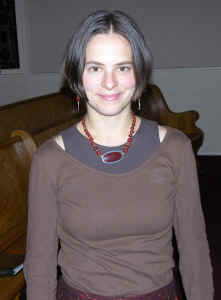
Kaeza Fearn |
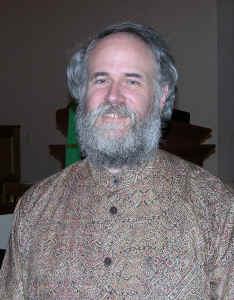
Peter Shea |
The music was an eclectic selection of music from people like
Robert
Schumann, Mrs. H. H. A. Beech, Greig, and Edward MacDowell.
There were
three distinct settings of Heinrich Heine’s poem “Der
Fichtenbaum”.
Heine is a hobby of Peter Shea. He has a database of over 8,000
adaptations of Heine’s work, and that is just for one or two
voices and
piano. He personally has collected 1,200 adaptations (he might
have
said more - I am not sure). One of these adaptations was written
by
Kaeza Fearn - First performance of a new song composed for this
occasion. Kaeza attended the concert event. The entire program
was
excellently organized. I enjoyed the mix of readings and music
and
believe this format should be continued in the concert next year
- if we
can get Monica to organize another concert.
After the concert everyone headed back to Monica and Bob’s
houses. The
next morning a trip to Ice Glen was planned. Will Blozan was
going to
climb the large Ice Glen Pine and calculate the volume of the
tree. We
arrived and congregated at the parking lot. Just as I was to
head off
into the woods, I realized I had forgotten something in my
tracker. I
headed back while everyone else continued on. I accidentally
broke out
the rear passenger side window and shattered glass everywhere.
In a
panic I caught up to Anthony Kelly and got him to move his jeep
while I
went looking for something to patch the big hole. If I were to
drive
back today and it rained, it would be a disaster unless I got it
fixed.
I took off while the others continued. I stopped at four
different gas
stations - the only thing open Sunday morning in MA - before I
collected
enough cardboard and duct Tape to patch the window. By then I
was
several miles away, it was an hour and a half later. I didn’t
know
where in the area the pine was located, I figured that Will had
already
climbed the tree, so I missed my video op, so I decided to head
home.
Halfway home my Tracker started smoking badly and running rough.
I
stopped a couple times, added oil, but eventually I just had to
stop and
call a tow truck. My vehicle had a major oil leak, the rear
lower motor
seal was shot. The Tracker was dead…. It would cost more to
fix it than
I could sell it for. I called my friends and cousins to come get
me.
My cousin Rob was the first to be home, so he drove out and
picked me up
after a 7 hour wait at Wendy’s.
There are other reports and photos of the tree climb at Ice
Glen. I
heard rumors of a “Home Alone” style event in which John
Eicholz was
left behind at Ice Glen….
Ed Frank
|